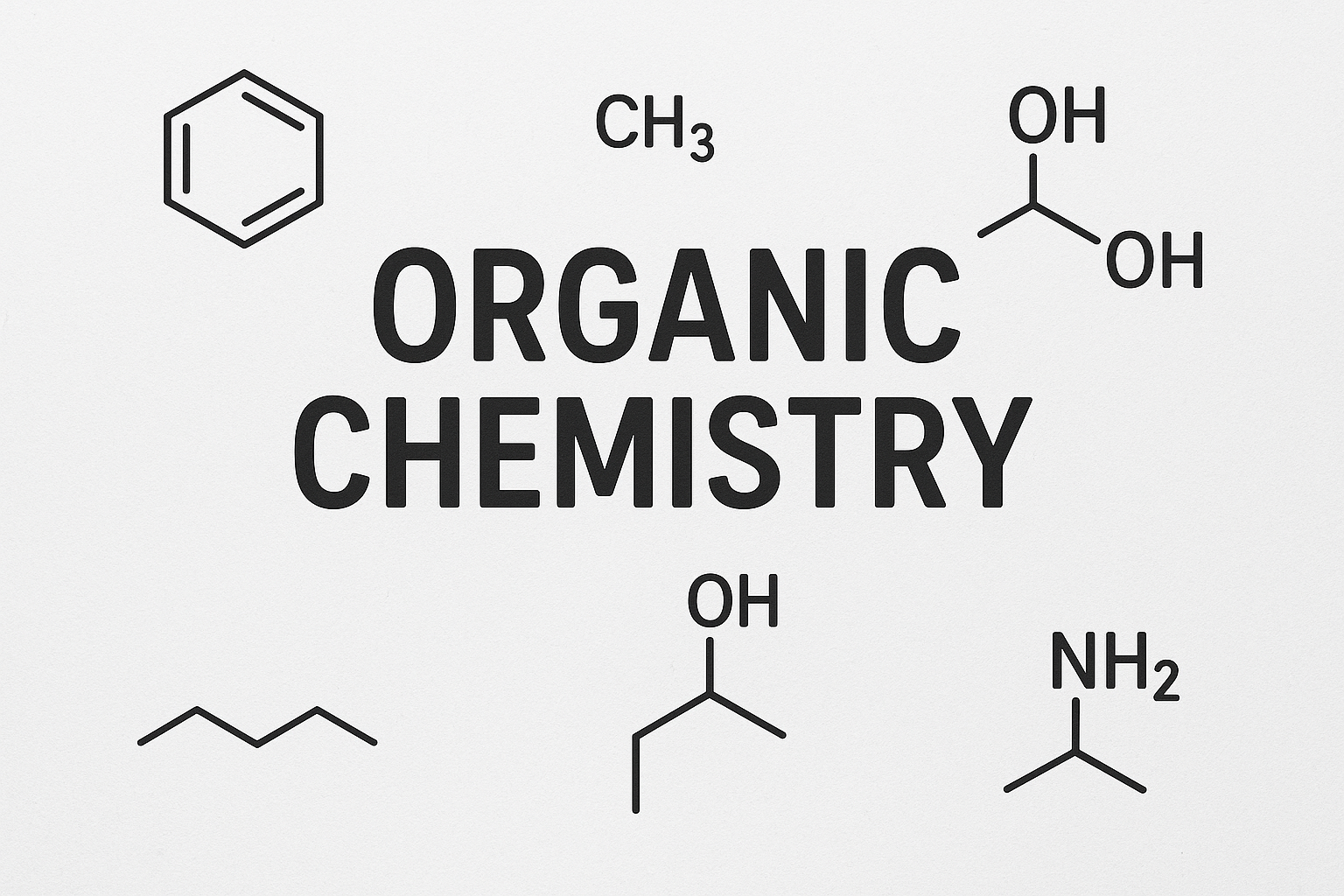
Course Title: Organic Chemistry
Organic Chemistry is the study of carbon compounds — the chemicals that make up living things and many materials we use daily, such as medicines, fuels, plastics, and food.
In this course, you will learn how organic compounds are structured, how they react, and how they are made.
Course Objectives:
After completing this course, you should be able to:
1. Explain what makes carbon special and why it forms so many compounds.
2. Recognize and name different types of organic compounds.
3. Understand how and why organic reactions happen.
4. Identify the main functional groups and their reactions.
5. Carry out simple organic experiments safely.
Course Outline (Simplified and Explained):
1. Introduction to Organic Chemistry
Definition of Organic Chemistry: Study of compounds containing carbon.
Why Carbon is Unique: It can form four bonds (tetravalency), join to itself (catenation), and form chains, rings, and complex structures.
Bonding in Organic Compounds:
Single bonds (sigma, σ)
Double and triple bonds (π bonds)
Representation of structure:
Molecular, structural, condensed, and skeletal formulas.
2. Naming (Nomenclature) of Organic Compounds
To illustrate clearly, chemists use IUPAC rules to name compounds.
You’ll learn to name:
Alkanes (only single bonds)
Alkenes (double bonds)
Alkynes (triple bonds)
Aromatic compounds (like benzene)
Compounds with functional groups (alcohols, acids, amines, etc.)
Also covered:
Isomerism: Compounds with the same formula but different structures or arrangements.
3. Hydrocarbons
These are the simplest organic compounds made up of carbon and hydrogen only.
(a) Alkanes
Structure: single C–C bonds
Example: methane (CH₄), ethane (C₂H₆)
Reactions: combustion, substitution with halogens
(b) Alkenes
Contain C=C double bonds
Example: ethene (C₂H₄)
Reactions: addition (with hydrogen, halogens, or acids)
(c) Alkynes
Contain C≡C triple bonds
Example: ethyne (acetylene)
Reactivity similar to alkenes but stronger
(d) Aromatic Compounds
Contain benzene rings
Example: benzene (C₆H₆)
Undergo substitution reactions
4. Functional Groups and Their Reactions
Functional groups are the reactive parts of organic molecules.
Functional Group Example Common Reactions
Halides (–Cl, –Br) CH₃Cl Substitution
Alcohols (–OH) CH₃OH Oxidation, dehydration
Aldehydes (–CHO) CH₃CHO Oxidation to acids
Ketones (C=O) CH₃COCH₃ Reduction
Carboxylic acids (–COOH) CH₃COOH Esterification
Amines (–NH₂) CH₃NH₂ Basic reactions, acylation
You’ll study how these compounds are prepared, their properties, and how they react.
5. Reaction Mechanisms
Types of reactions:
Substitution (one atom replaces another)
Addition (atoms add to a double or triple bond)
Elimination (atoms are removed to form a double bond)
Rearrangement (atoms shift positions inside a molecule)
Reaction intermediates: short-lived species such as carbocations, carbanions, and free radicals.
Understanding mechanisms helps explain why reactions occur.
6. Stereochemistry
Stereochemistry studies the 3-D arrangement of atoms.
Chirality: when a molecule has a “handedness” (like right and left hands).
Optical isomers: rotate plane-polarized light differently.
Geometric isomers: differ in arrangement around a double bond (cis- and trans- forms).
7. Organic Synthesis and Laboratory Techniques
Synthesis: Building complex compounds from simpler ones.
Purification methods:
Distillation (separating liquids)
Crystallization (purifying solids)
Chromatography (separating mixtures)
Qualitative tests: identifying unknown compounds (e.g., test for alcohols or carboxylic acids).
8. Biomolecules
Organic chemistry also explains life molecules:
Carbohydrates: sugars and starches – energy sources
Proteins: made of amino acids – building blocks of cells
Lipids: fats and oils – energy storage
Nucleic acids: DNA and RNA – genetic material
Assessment
Continuous assessment (40%) – quizzes, assignments, lab reports
Final exam (60%) – theory and practical test
- Teacher: Admin User